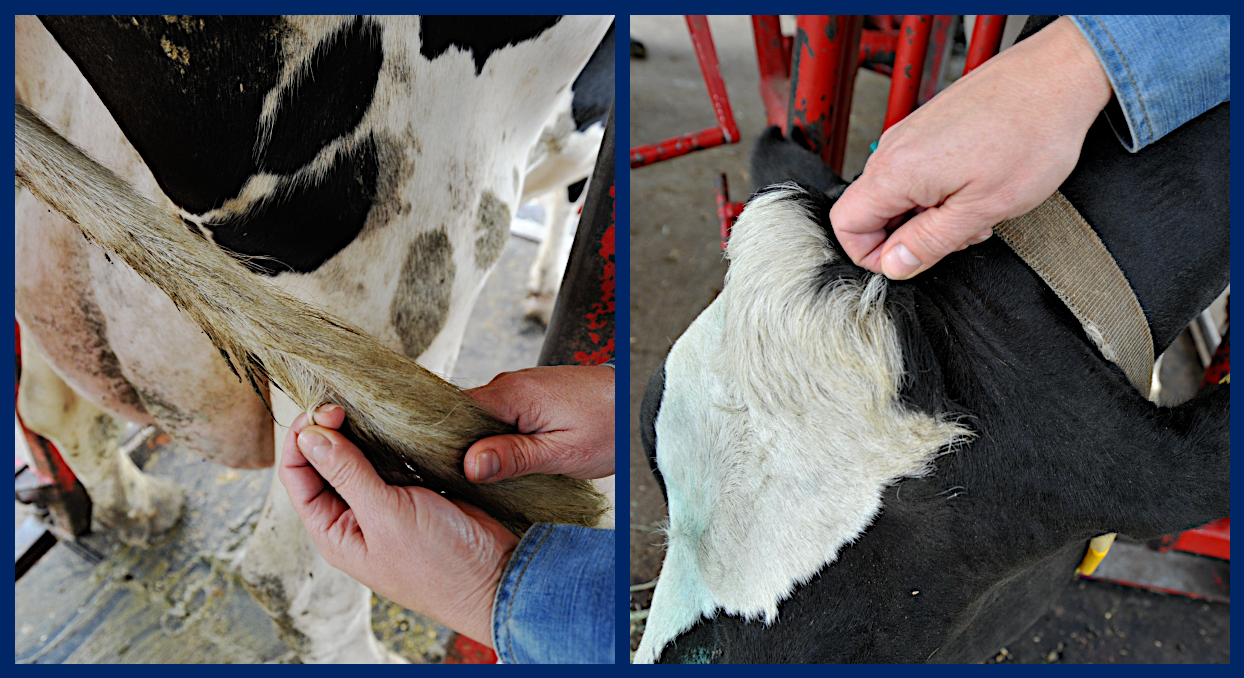Quick Summary
Cattle Milk Protein Panel
$93 per animal
Sample Collection
Most of the cattle DNA tests offered by the VGL are carried out using cells from the roots of a hair sample (roughly 20-30 hairs).
Hair samples should be taken from the switch of the tail, the poll, or the neck.

1. Clean (use comb if possible) tail switch, poll, or neck by removing all loose hair and foreign matter.
2. Use fingers or pliers to grasp approximately 8-10 hairs close to the skin and pull. Pull (do NOT cut) hair strands. Examine the end of hair strands for presence of root bulbs. Hair roots are necessary for DNA testing. If the majority of hair strands lack the root bulbs, discard hair and start again.
3. Repeat until you have approximately 20-30 hairs with root follicles attached.
4. Place the 20-30 hairs with root follicles attached in the envelope and seal with the animal’s ID written on the envelope. If hairs are long they can be taped to the submission form. Do not tape the roots.

5. Repeat steps 1-4 for each additional animal being sampled.
Note:
- Hair should be dry.
- If hair has excess dirt and debris, please brush out if possible before pulling hairs for sample.
- Do not cut the hair! The roots contain the DNA for testing.
- When sampling several animals in the same session, make sure that there are no hair strands in your hands to reduce the possibility of sample contamination. Clean hands and/or pliers if possible.
The solids found in cow’s milk are composed of fat, protein, lactose and minerals. Beta-casein is one of six milk proteins and is produced by the CSN2 gene. Fifteen genetic variants of CSN2 are known, which cause changes of certain amino acids in the beta-casein protein and alter its properties. Based on the amino acid in position 67, these variants can be classified into 2 groups - A1 and A2. Variants that belong to the A1 group (His67) are A1, B, C, F and G. Variants that belong to the A2 group (Pro67) are A2, A3, H1, H2, I, J, K and L. The levels of bioactive peptide beta-casomorphin 7 (BCM7) produced from the metabolism of beta casein is several-fold higher for variants in the A1 group than in the A2 group. Higher levels of BCM7 have been associated with negative health effects in humans. Relative to levels of BCM7 production, variants within each group behave similarly but may differ in other properties.
This test identifies variants within the A1 and A2 groups thus providing a more detailed resolution of the beta casein gene in cattle. Breeders interested in developing herds for human health benefits should focus in selecting against variants of the A1 group (A1-free). Breeders interested in cows that only produce A2 milk should select for cows with A2/A2 or I/I genotypes.
The A2 genotyping test as specified by the A2 Milk Company classifies beta casein only according to the A1 and A2 group designation. The correspondence between the new VGL results and the group designation for common variants detected in cattle are provided below as an example. The same principle applies to other less frequent variants.
Table 1. Correspondence of genotypes between the new VGL test (variant-based) and A2 Milk Company nomenclature (group-based)
| Variant based result | Group based equivalent |
| A1/A1 * | A1/A1 |
| A1/B * | A1/A1 |
| B/B * | A1/A1 |
| A1/A2 ** | A1/A2 |
| A1/I ** | A1/A2 |
| B/I ** | A1/A2 |
| A2/A2 *** | A2/A2 |
| A2/B ** | A1/A2 |
| A2/I *** | A2/A2 |
| I/I *** | A2/A2 |
* Cows with this genotype produce milk with A1 protein
** Cows with this genotype produce milk with both A1 and A2 proteins
*** Cows with this genotype produce milk with A2 protein only
Table 2 below summarizes raw percentage frequency of variants observed among samples tested with the new VGL test. Breed classification is as provided with samples and may include crossbred animals if this information was not disclosed. Although the numbers may not represent actual frequency in breeds, the table provides information about which variants are observed and how common they may be in the different breeds.
Table 2. Percent frequency of beta casein variants among samples tested by the VGL. Frequencies may be biased as they are not based on random sampling of each breed.
| Breeds | # of animals | Beta casein variants | |||||
| A1 | A2 | B | C | F | I | ||
| Brown Swiss | 8 | 93.8 | 6.3 | ||||
| Devon | 6 | 50.0 | 25.0 | 25.0 | |||
| Dexter | 78 | 32.7 | 60.3 | 6.4 | 0.6 | ||
| Guernsey | 6 | 8.3 | 75.0 | 16.7 | |||
| Holstein | 17 | 8.8 | 70.6 | 2.9 | 2.9 | 14.7 | |
| Jersey | 40 | 6.3 | 65.0 | 17.5 | 11.3 | ||
| Jersey Cross | 15 | 16.7 | 56.7 | 26.7 | |||
| Mini Jersey | 14 | 21.4 | 50.0 | 25.0 | 3.6 | ||
| Shorthorn | 8 | 25.0 | 75.0 |
For more information about A2 Corporation and A2 Milk®, visit the A2 Milk Company Website
Other dairy milk protein tests offered by the VGL: Kappa casein, Beta lactoglobulin
